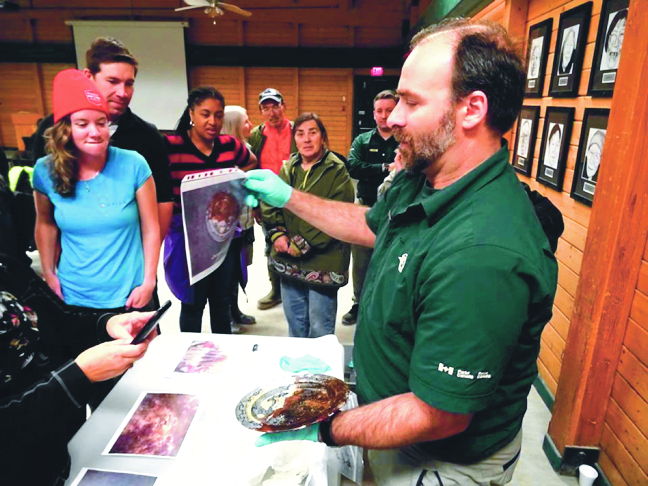Debate continues to rage in Nunavut over Franklin expedition relics
After attending the first annual Umiyaqtutt Festival in his community to celebrate the discoveries of the Franklin shipwrecks, Gjoa Haven’s MLA, Tony Akoak, wants to know when, if ever, HMS Terror and HMS Erebus artifacts will ever be displayed for his constituents
Complaints over the absence of Franklin artifact exhibits in Nunavut have been common since the Erebus was found in Kitikmeot waters in September 2014—and Akoak raised the issue again Sept. 13, in Nunavut’s legislature.

“These artifacts tell a story of our ancestors and demonstrate the strength of oral history and traditions,” Akoak said, in reference to artifacts recovered from the wrecks of the two fated Royal Navy ships that sunk during the 1845 Franklin Expedition.
“I hope to see these artifacts displayed across the territory in the future,” he said.
Akoak reminded his legislature colleagues that the Erebus artifacts are currently on display at the National Maritime Museum in London, England, together with a series of related British relics.
That exhibition is scheduled to make an appearance at the Canadian Museum of History in Gatineau, Quebec, in 2018.
Replica Franklin artifacts, and an interactive virtual display of the Erebus discovery, have been shown in Nunavut. Parks Canada officials say they would like to show the real artifacts to Nunavut residents but right now, Nunavut doesn’t have the tools or proper facilities to display the fragile relics.
“There is no space in Nunavut to display the artifacts,” Culture and Heritage Minister George Kuksuk said. “The artifacts can’t just be shown. [They have] to have the proper air and they need ventilation in the building where they are displayed.”
There are plans, however, to build a “multi-functional facility for research, conservation and presentation of artifacts in Gjoa Haven.” But that is still in the planning stages.
Kuksuk said the Government of Nunavut has a partnership with the Winnipeg Art Gallery to store Inuit art and artifacts for now. He said his department also works with a handful of other similar organizations, but he did not list them.
Specialized facilities aside, there is still debate over who owns, and has ultimate control over, the Franklin artifacts. Akoak said he asked a question about artifact ownership in the spring sitting, but didn’t get a clear answer.
Since the wrecks were Royal Navy ships, the artifacts are currently under British ownership, but Parks Canada is working for joint ownership for Canada and Kitikmeot Inuit.
Akoak also asked Kuksuk about the current state of permits for the Franklin sites.
“It is still unclear to me what specific permits have been issued to date and what entities have access to the two Franklin Expedition wreck sites, HMS Erebus and HMS terror,” Akoak said. “Can you give me a clear list of all entities that currently have permission to access expedition wreck sites, and remove artifacts?”
Permitting around the Franklin discoveries has been contentious for the Franklin discoveries from the get-go.
Kuksuk did not know what permits, or how many, have been issued, but said staff would be able to answer the member’s question later.
“There are permits, we are responsible for that,” said Kuksuk, adding that the department reviews and approves or denies any permits related to work at the wreck sites.
Akoak’s third question had to do with Inuit participation.
Under Article 33 of the Nunavut Land Claims Agreement, archeological artifacts found within the Nunavut settlement area are owned jointly by Inuit and by government.
The NCLA also states that the Inuit Heritage Trust is responsible for “supporting, encouraging and facilitating the conservation, maintenance, restoration and display of archeological sites and specimens in the Nunavut settlement area,” Akoak pointed out.
“Can the minister clearly describe how Parks Canada and the Government of Nunavut are working with the Inuit Heritage Trust to ensure that each trustee has the opportunity to provide expertise, and advice on all plans and events concerning the Franklin Expedition artifacts?” he asked.
Kuksuk called Akoak’s questions both “good” and “interesting,” but the minister’s replies were vague.
“We are always working with those groups,” Kuksuk said. “We will continue the partnerships with the Inuit Heritage Trust that he referred to and the other organizations like the Kitikmeot Inuit Association.”
“We work on a continuing basis with Parks Canada and Heritage Canada and especially [with] my colleague’s community.”
The KIA is currently negotiating an Inuit Impact and Benefit Agreement for the Terror and Erebus sites. Meetings for the IIBA were scheduled to continue this month. As well, Parks Canada is working with the Nunavut Impact Review Board to include the sites in an existing national heritage site.